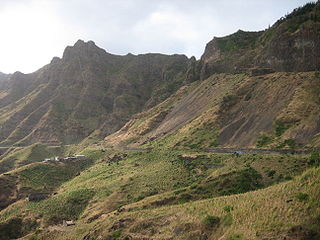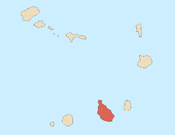| Milho Branco (do Norte) | |
|---|---|
| Settlement | |
| Coordinates: 15°14′15″N23°43′42″W / 15.2376°N 23.7283°W Coordinates: 15°14′15″N23°43′42″W / 15.2376°N 23.7283°W | |
| Country | Cape Verde |
| Island | Santiago |
| Municipality | Tarrafal |
| Civil parish | Santo Amaro Abade |
| Population (2010) [1] | |
| • Total | 165 |
Milho Branco do Norte, locally and commonly as Milho Branco, also as Milho Branco sobre Mau Passo for outsiders is a settlement and a plateau in the northcentral part of the island of Santiago, Cape Verde and is part of the municipality of Tarrafal. Its 2010 population was 165. It is located about 5 km southeast of Tarrafal and is linked with the EN1-ST01 with a branch road. In 1983, the Primary Route 1 (then LBRS1) was rerouted into the settlement, running through the middle of Serra Malagueta and the then branch road that connected with Achada Longueira as well as Chão Bom and Lagoa. [2]

Santiago is the largest island of Cape Verde, its most important agricultural centre and home to half the nation’s population. Part of the Sotavento Islands, it lies between the islands of Maio and Fogo. It was the first of the islands to be settled: the town of Ribeira Grande was founded in 1462. Santiago is home to the nation's capital city of Praia.

Cape Verde or Cabo Verde, officially the Republic of Cabo Verde, is an island country spanning an archipelago of 10 volcanic islands in the central Atlantic Ocean. It forms part of the Macaronesia ecoregion, along with the Azores, Canary Islands, Madeira, and the Savage Isles. In ancient times these islands were referred to as "the Islands of the Blessed" or the "Fortunate Isles". Located 570 kilometres (350 mi) west of the Cape Verde Peninsula off the coast of Northwest Africa, the islands cover a combined area of slightly over 4,000 square kilometres (1,500 sq mi).

Tarrafal is a concelho (municipality) of Cape Verde. It is situated in the northern part of the island of Santiago. Its seat is the town Tarrafal. Its population was 18,565 at the 2010 census, and its area is 120.8 km2.
As there is Milho Branco in the east of São Domingos, secondarily known as Minho Branco, to outsiders, the settlement near Chão Bom is known as Milho Branco do Norte or Milho Branco sobre Mau Passo.

Milho Branco is a village in the southeastern part of the island of Santiago, Cape Verde. It is situated 2 km north of Ribeirão Chiqueiro, 5 km east of the city São Domingos and 12 km north of the capital Praia. The national road EN1-ST02 from Ribeirão Chiqueiro to Tarrafal via Pedra Badejo passes through the village. It is part of the municipality of São Domingos. In 2010 its population was 607.

São Domingos is a concelho (municipality) of Cape Verde. It is situated in the southeastern part of the island of Santiago. Its seat is the city São Domingos. Its population was 13,699 at the 2010 census, and its area is 147.5 km2.

Chão Bom is a settlement in the northern part of the island of Santiago, Cape Verde. It is situated near the west coast, 3 km southeast of Tarrafal on the main road (EN1-ST01) south to Assomada and Praia. In 2010 its population was 5,166. The Tarrafal prison camp was situated north of Chão Bom. The stadium Estádio de Mangue is in the northwestern part in the communal limits. Silvino Lopes Évora, a writer, poet, journalist and a university professor is native to Chão Bom.
The settlement is named a white mill that mainly a sugar mill. Sugar mills, even in that area are dominant even today.
It is midway near Ribeira de Mau Passo, a stream flowing northwest into the Atlantic at Baía de Chão Bom.

The Atlantic Ocean is the second largest of the world's oceans, with an area of about 106,460,000 square kilometers. It covers approximately 20 percent of the Earth's surface and about 29 percent of its water surface area. It separates the "Old World" from the "New World".
Most of the area are hilly and mountainous being, it forms a northernmost part of the Serra Malagueta ranges. Agriculture is its main economy.
In the mid-20th century, the settlement had a large Rabelados population.
The Rabelados are a religious community primarily found in the interior of the island of Santiago of Cape Verde. They were among the groups which revolted against the liturgical reforms of the Catholic Church introduced in the 1940s, isolating themselves from the rest of society.







